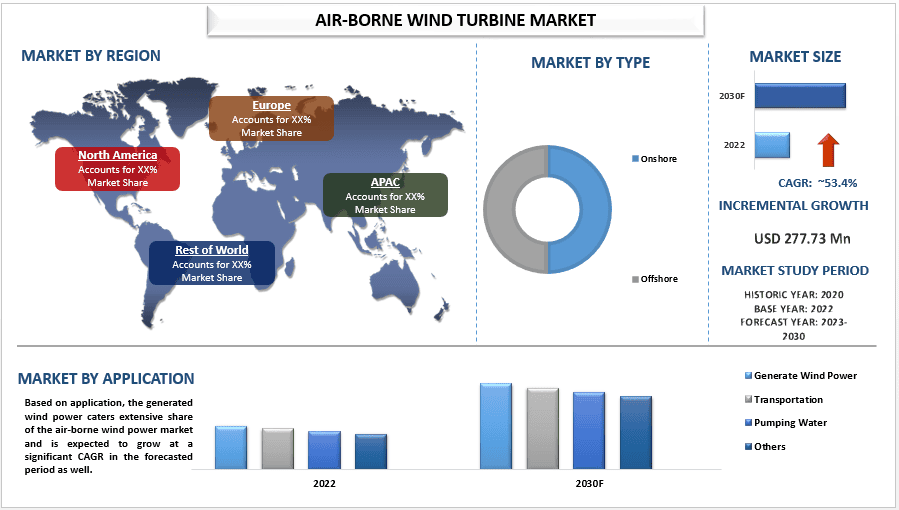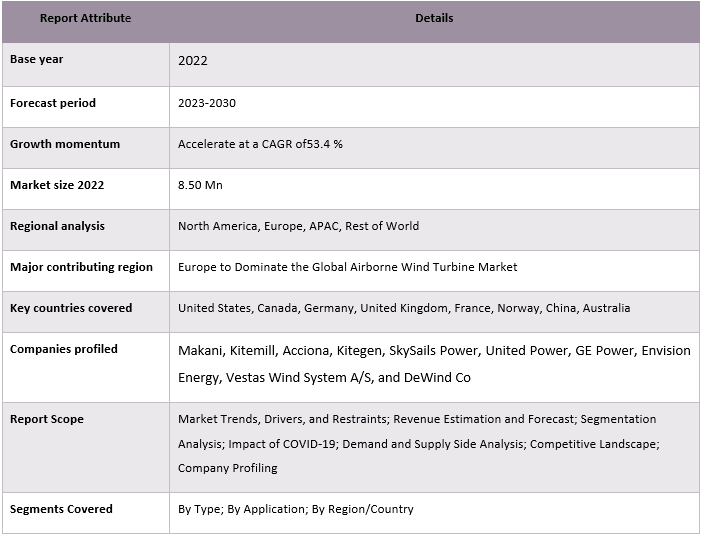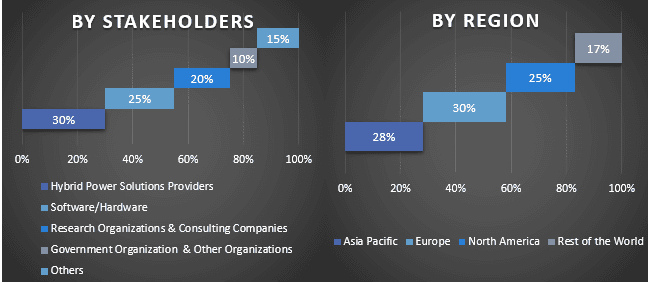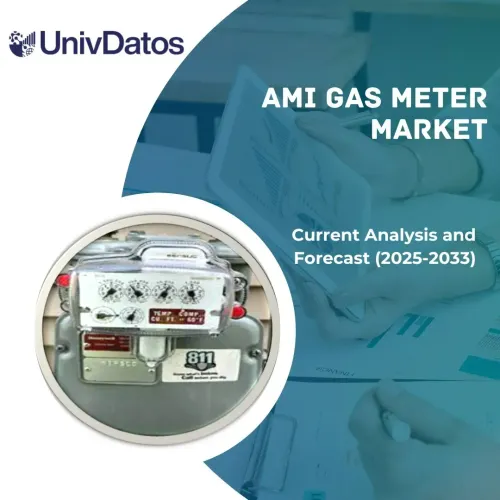- Home
- About Us
- Industry
- Services
- Reading
- Contact Us
Air-Borne Wind Turbine Market: Current Analysis and Forecast (2023-2030)
Emphasis on Type (Onshore, Offshore); Application (Generate Wind Power, Transportation, Pumping Water, Others); and Region/Country

Global Airborne wind turbine Market is expected to reach USD 277.73 Million in 2030 by growing at a CAGR of 8.6%. factors such as the growing demand for renewable energy, advancements in technology, declining costs, expanding applications, government support and incentives, increasing awareness about the benefits of AWTs, and rising competition have contributed to the growth of AWTs. As people become more aware of climate change and the need for sustainable energy sources, the demand for renewable energy technologies like AWTs has increased. Furthermore, improvements in AWT design, materials, and manufacturing processes have made them more efficient, reliable, and cost-effective, making them a compelling option for renewable energy generation.
For instance, In 2021, RWE Renewables GmbH and SkySails Power GmbH came into collaboration for pilot projects in Mauritius. They planned to fly a 120-sqm kite to a height of up to 400 meters above ground to utilize high-altitude winds for generating electricity.
Makani, Kitemill, Acciona, Kitegen, SkySails Power, United Power, GE Power, Envision Energy, Vestas Wind System A/S, and DeWind Co. are some of the key players in the market. Several M&As along with partnerships have been undertaken by these players to facilitate customers with hi-tech and innovative products/technologies.
Insights Presented in the Report
“Amongst type, offshore category to witness higher CAGR during the forecast period.”
Based on the type, the airborne wind turbine market is bifurcated into onshore and offshore. The offshore segment caters to significant demand in 2022. Offshore airborne wind turbines are cost-effective and more feasible in deeper offshore locations than their traditional counterparts which will further escalate their share in the airborne wind turbine industry.
“Amongst application, the transportation segment to hold a significant share in the market in 2022.”
Based on application, the airborne wind turbine market is categorized into generating wind power, transportation, pumping water, and others. The transportation segment holds a major share of this market. This is mainly owing to the growing demand for renewable energy in marine transport which further propels the opportunities for airborne wind turbine adoption in the transportation sector.
“Europe to hold a considerable share in the market.”
Europe is expected to experience the highest share in the airborne wind turbine market. The primary factor driving this growth is the increase in the onshore wind capacity to meet the net zero vision. In addition, the ability of airborne wind energy to be cost-competitive with other generation sources at a commercial scale by 2030 as AWE has lower logistics requirements than established wind technology, which allows it to be installed in places that established wind cannot reach is further accelerating the market size of airborne wind turbine in Europe.

Reasons to buy this report:
- The study includes market sizing and forecasting analysis validated by authenticated key industry experts.
- The report presents a quick review of overall industry performance at one glance.
- The report covers an in-depth analysis of prominent industry peers with a primary focus on key business financials, product portfolio, expansion strategies, and recent developments.
- Detailed examination of drivers, restraints, key trends, and opportunities prevailing in the industry.
- The study comprehensively covers the market across different segments.
- Deep dive regional level analysis of the industry.
Customization Options:
The global Airborne wind turbine market can further be customized as per the requirement or any other market segment. Besides this, UMI understands that you may have your own business needs, hence feel free to connect with us to get a report that completely suits your requirements.
Table of Content
Research Methodology for the Airborne wind turbine Market Analysis (2023-2030)
Analyzing the historical market, estimating the current market, and forecasting the future market of the global Airborne wind turbine market were the three major steps undertaken to create and analyze the adoption of Airborne wind turbine in major regions globally. Exhaustive secondary research was conducted to collect the historical market numbers and estimate the current market size. Secondly, to validate these insights, numerous findings and assumptions were taken into consideration. Moreover, exhaustive primary interviews were also conducted, with industry experts across the value chain of the global Airborne wind turbine market. Post assumption and validation of market numbers through primary interviews, we employed a top-down/bottom-up approach to forecasting the complete market size. Thereafter, market breakdown and data triangulation methods were adopted to estimate and analyze the market size of segments and sub-segments of the industry pertains to. Detailed methodology is explained below:
Analysis of Historical Market Size
Step 1: In-Depth Study of Secondary Sources:
Detail secondary study was conducted to obtain the historical market size of the Airborne wind turbine market through company internal sources such as annual reports & financial statements, performance presentations, press releases, etc., and external sources including journals, news & articles, government publications, competitor publications, sector reports, third-party database, and other credible publications.
Step 2: Market Segmentation:
After obtaining the historical market size of the Airborne wind turbine market, we conducted a detailed secondary analysis to gather historical market insights and share for different segments & sub-segments for major regions. Major segments are included in the report as type and application. Further country-level analyses were conducted to evaluate the overall adoption of testing models in that region.
Step 3: Factor Analysis:
After acquiring the historical market size of different segments and sub-segments, we conducted a detailed factor analysis to estimate the current market size of the Airborne wind turbine market. Further, we conducted factor analysis using dependent and independent variables such as type and application of Airborne wind turbine. A thorough analysis was conducted of demand and supply-side scenarios considering top partnerships, mergers and acquisitions, business expansion, and product launches in the Airborne wind turbine market sector across the globe.
Current Market Size Estimate & Forecast
Current Market Sizing: Based on actionable insights from the above 3 steps, we arrived at the current market size, key players in the global Airborne wind turbine market, and market shares of the segments. All the required percentage shares split, and market breakdowns were determined using the above-mentioned secondary approach and were verified through primary interviews.
Estimation & Forecasting: For market estimation and forecast, weights were assigned to different factors including drivers & trends, restraints, and opportunities available for the stakeholders. After analyzing these factors, relevant forecasting techniques i.e., the top-down/bottom-up approach were applied to arrive at the market forecast for 2030 for different segments and sub-segments across the major markets globally. The research methodology adopted to estimate the market size encompasses:
- The industry’s market size, in terms of revenue (USD) and the adoption rate of the Airborne wind turbine market across the major markets domestically
- All percentage shares, splits, and breakdowns of market segments and sub-segments
- Key players in the global Airborne wind turbine market in terms of products offered. Also, the growth strategies adopted by these players to compete in the fast-growing market.
Market Size and Share Validation
Primary Research: In-depth interviews were conducted with the Key Opinion Leaders (KOLs) including Top Level Executives (CXO/VPs, Sales Head, Marketing Head, Operational Head, Regional Head, Country Head, etc.) across major regions. Primary research findings were then summarized, and statistical analysis was performed to prove the stated hypothesis. Inputs from primary research were consolidated with secondary findings, hence turning information into actionable insights.
Split of Primary Participants in Different Regions

Market Engineering
The data triangulation technique was employed to complete the overall market estimation and to arrive at precise statistical numbers for each segment and sub-segment of the global Airborne wind turbine market. Data was split into several segments & sub-segments post studying various parameters and trends in the areas of type and application in the global Airborne wind turbine market.
The main objective of the Global Airborne wind turbine Market Study
The current & future market trends of the global Airborne wind turbine market were pinpointed in the study. Investors can gain strategic insights to base their discretion for investments on the qualitative and quantitative analysis performed in the study. Current and future market trends determined the overall attractiveness of the market at a regional level, providing a platform for the industrial participant to exploit the untapped market to benefit from a first-mover advantage. Other quantitative goals of the studies include:
- Analyze the current and forecast market size of the Airborne wind turbine market in terms of value (USD). Also, analyze the current and forecast market size of different segments and sub-segments.
- Segments in the study include areas of type and application.
- Define and analysis of the regulatory framework for the Airborne wind turbine
- Analyze the value chain involved with the presence of various intermediaries, along with analyzing customer and competitor behaviors of the industry.
- Analyze the current and forecast market size of the Airborne wind turbine market for the major region.
- Major countries of regions studied in the report include Asia Pacific, Europe, North America, and the Rest of the World.
- Company profiles of the Airborne wind turbine market and the growth strategies adopted by the market players to sustain in the fast-growing market.
- Deep dive regional level analysis of the industry
Frequently Asked Questions FAQs
Q1: What is the current market size and growth potential of the global Airborne wind turbine market?
Q2: What are the driving factors for the growth of the global Airborne wind turbine Market?
Q3: Which segment has the largest share of the global Airborne wind turbine market by Type?
Q4: What are the emerging technologies and trends in the global Airborne wind turbine market?
Q5: Which region will dominate the global Airborne wind turbine market?
Related Reports
Customers who bought this item also bought










